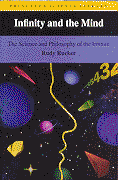


INTRODUCTION
Fortunately, after “twenty” it all breaks down to a pretty simple system, and the rest is easy. We turned our attention, gratefully, to other things. Still, though, the fact that it never ends remained psychologically vexing for most of us. All children try at some point to see how high they can count, even having contests about it. Perhaps this activity is born, at least in part, of the felt need to challenge this notion of endlessness – to see if it really holds up to experiment. “Infinity,” we called it, and used the word cheerfully whenever we needed it.
“You're a dumby, nyah nyah!”... to the last of which a good answer was hard to find. How could you get bigger than infinity? Infinity plus one? And what's that?
“Oh yeah? Well you're twice as dumb!”
“Well . . . you're a hundred times as dumb!”
“Well you're a million times . . .”
“Well you're infinity times . . .”
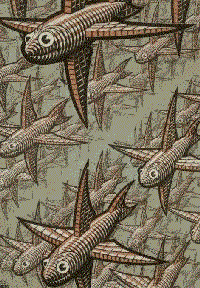 Fish, by M.C. Escher |
Infinity, of course, infected our imaginations, and for some of us it cropped up in our conscious thoughts every now and then in new and interesting ways. I had nightmares for years in which I would think of something doubling in size. And then doubling again. And then doubling again. And then doubling again. And then
Another form this dream took was “something inside of something,” and then all of that inside something else, and all of that inside something else, and
There are many ways infinity can catch our imagination. Everyone has wondered if the universe is infinite, for instance. It is an easy mistake to conclude that it must be, reasoning that if it wasn't then it would have to have a boundary, and then what would be on the other side? The answer to this is that the universe may be like a sphere. The surface of a sphere doesn't have a boundary, but it is certainly finite in area. (The universe, in other words, could be like a three-dimensional surface of a sphere which can be imagined as existing in four-dimensional space – most cosmologists think it may well be something like that.) Another common line of thought runs like this: if the universe is infinite, then it must have an infinite number of planets, and therefore a planet just like this one except that everyone is bald (or talks backwards, or what have you).
The trouble here is in thinking that an infinite set must contain everything. However, a little thought shows that this needn't be true.
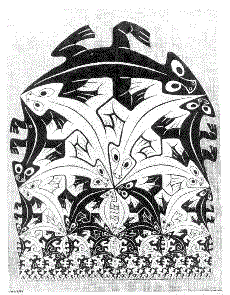 Regular Division of the Plane VI, by M.C. Escher |
Infinities don't have to be large, of course – they can also be small. Instead of something doubling in size, it could be halved. And then halved again. And then halved again. And then halved again. And then
THE HISTORY OF INFINITY
Since no sensible magnitude is infinite, it is impossible to exceed every assigned magnitude; for if it were possible there would be something bigger than the heavens.Aristotle distinguished between the potential infinite, and the actual infinite. The natural numbers, he would say, are potentially infinite because they have no greatest member. However, he would not allow that they are actually infinite, as he believed it impossible to imagine the entire collection of natural numbers as a completed thing. He taught that only the potential infinite is permissible to thought, since any notion of the actual infinite is not “sensible.” So great was Aristotle's influence that more than 2,000 years later we find the great mathematician Karl Friederich Gauss admonishing a colleague,
As to your proof, I must protest most vehemently against your use of the infinite as something consumated, as this is never permitted in mathematics. The infinite is but a figure ofNonetheless, long before Gauss's time, cracks had begun to appear in the Aristotelian doctrine. Galileo (b. 1564) had given the matter much thought, and noticed the following curious fact: if you take the set of natural numbers and remove exactly half of them, the remainder is as large a set as it was before. This can be seen, for example, by removing all the odd numbers from the set, so that only the even numbers remain. By then pairing every natural number n with the even number 2n, we see that the set of even numbers is equinumerous with the set of all natural numbers. Galileo had hit upon the very principle by which mathematicians in our day actually define the notion of infinite set, but to him it was too outlandish a result to warrant further study. He considered it a paradox, and “Galileo's Paradox” it has been called ever since.speech . . . .
As the modern study of mathematics came into full bloom during the seventeenth and eighteenth centuries, more and more mathematicians began to sneak the notion of an actual infinity into their arguments, occasionally provoking a backlash from more rigorous colleagues (like Gauss).
 John Wallis |
Ten years later, Isaac Newton in England and Gottfried Leibnitz in Germany (working independently) began their development of the calculus, which involved techniques that all but demanded the admission of actual infinities. Newton side-stepped the issue by introducing an obscure notion called “fluxions,” the precise nature of which was never made clear. Later he changed the terminology to “the ultimate ratio of evanescent increments”.
The discovery of the calculus opened the way to the study of mathematical analysis, in which the issue of actual infinities becomes very difficult indeed to avoid. All through the nineteenth century, mathematicians struggled to preserve the Aristotelian doctrine, while still finding ways to justify the marvelous discoveries which their investigations forced upon them.
Finally, in the early 1870's, an ambitious young Russian/German mathematician named Georg Cantor upset the applecart completely. He had been studying the nature of something called trigonometric series,
One can without qualification say that the transfinite numbers stand or fall with the infinite irrationals; their inmost essence is the same, for these are definitely laid out instances or modifications of the actual infinite. | ||
| – Georg Cantor |
CANTOR'S SET THEORY
 |
Now, the real trouble with infinity is much the same: we can't count that high! Cantor's insight was that, even though we can't enumerate an infinite set, we can nonetheless apply the same procedure to any well-defined infinite set that we applied above to determining if our hands have the same number of fingers. In other words, we can determine if two infinite sets are the same “size” (equinumerous) by seeking to find a one-to-one match-up between the elements of each set. Now, remember Galileo's Paradox? Galileo noticed that we can do the following:

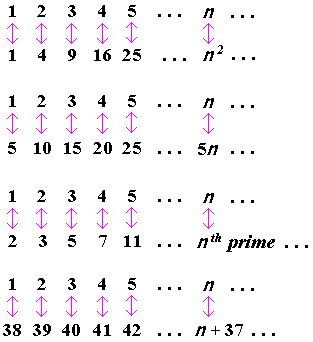
A set is infinite if we can remove some
of its elements without reducing its size.
Cantor's next great accomplishment was to ask the question, “do all infinite sets have the same cardinality?” In other words, can all infinite sets be put into a one-to-one match-up with the natural numbers? It is not difficult to find one-to-one matchups between the natural numbers and the integers (you should try to do this), so the first set to consider as
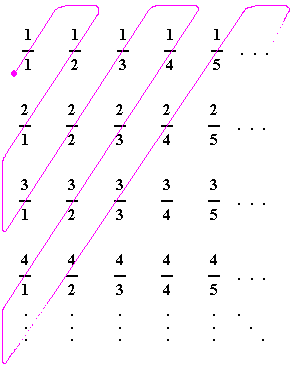
The next set to ask about, obviously, is the real numbers. After our experience with the rational numbers, it would be understandable to guess that, after all, countable infinities are the only kind of infinities there are in mathematics. But no! Cantor showed that the real numbers are cardinally larger than the natural numbers – in other words, there is no way to form a one-to-one match-up between the natural numbers and the real numbers that doesn't leave some of the real numbers out. To show this, Cantor invented a whole new kind of proof, which has come to be called “Cantor's diagonalization argument.”
Cantor's proof of the “nondenumerability” of the real numbers (the diagonalization argument) is somewhat more sophisticated than the proofs we have examined hitherto. However, laying aside some purely technical matters, we can provide a simplified – but still convincing – version of his proof in the following way. Remember that we are attempting to prove a negative statement: that the real numbers are not countable. As so often in such cases, we approach this issue through the back door, so to speak, with a proof by contradiction. In other words, we begin by assuming, for sake of argument, that the real numbers are countable. This would mean that we could form a one-to-one matchup of the natural numbers and the real numbers. Since real numbers may be represented in decimal form (with an integer part and a decimal part), this means that we could provide a numbered list of the real numbers which would look something like this:
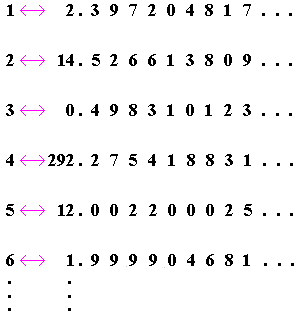
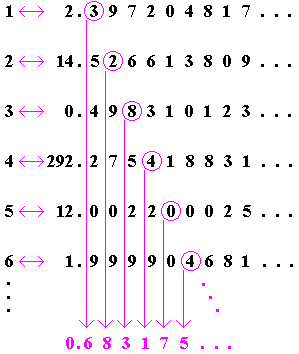
BUT – we assumed we had a complete list. This is a contradiction. Therefore, our assumption that we could make a countable list of the real numbers is false! The real numbers have a higher order of infinity than the natural numbers, i.e., they are cardinally greater. (It is natural to ask, “well, why not just add the new number to the list?” Indeed, we could do so. However, this fails to address the fundamental point of the argument: we assumed we had a complete list of real numbers, and then showed that this assumption cannot be true. It is the existence of this contradiction which forces the conclusion that the real numbers aren't countable. And of course, even if we added our new one to the list, we could use the same process to create infinitely more. There's just no way to create a completed “match-up” between the sets.)
CARDINALS
Now our set of cardinal numbers contains only two elements, but let's make an adjustment at once. Since cardinal numbers are used to describe the “sizes” of sets, it happens that we really want to call the natural numbers “cardinal numbers” too. After all, they describe the sizes of finite sets. And we may as well have zero, since that's the size of the empty set. Thus, the set of all cardinals will contain both kinds of cardinal; finite cardinals (which are just the natural numbers, really, together with zero) and what Cantor termed transfinite cardinals, which include our w and c.
cardinals = { 0, 1, 2, 3, . . . , w, c, . . . ? }
Notice the question mark. We haven't really settled whether there are any more transfinite cardinals. Fortunately, Cantor has done that for us, in what is now called Cantor's Theorem. It may be stated as follows.If X is any set, then there exists at least one set,The proof of Cantor's Theorem has a similar flavor to his proof of the nondenumerability of the real numbers, but it is somewhat more abstract. The intrepid will have little difficulty following it, however (see Cantor’s Theorem in the PRIME). It is an interesting fact that the power set of any countable set, i.e., of size w, has cardinality c, the size of the continuum.
the power set of X, which is cardinally larger than X.
What Cantor's Theorem tells us is that we can construct sets with greater and greater cardinalities. Cantor introduced a special notation for this heirarchy of cardinalities using the Hebrew letter aleph (pronounced AH-leff ), with numeral subscripts showing where they are in the heirarchy. Thus, aleph-null is the first infinite cardinal, and denotes the cardinality of the natural numbers (or any countably infinite set, i.e. of cardinality w), and aleph-one is the next cardinal number, standing for the next size of infinity, and so on.
![]()
What about c, the cardinality of the continuum? Cantor thought that it must be aleph-one, that is, that the size of the continuum was the next highest after the natural numbers. This conjecture is now called the continuum hypothesis. Cantor was never able to prove it, however, and this bothered mathematicians for many years. How could we be sure where the “size” of the real numbers fit in the scheme of things?
In the 1930’s, Kurt Gödel showed that the continuum hypothesis can't be disproved from the axioms of set theory, and in the 1960’s another mathematician named Paul Cohen showed that it cannot be proved, either. This is a very strange thing, and mathematicians have debated what it means ever since. At the very least, it means that our current understanding of sets is not strong enough to settle the question of the continuum. We have, at present, no way of determining where in the heirarchy of infinite cardinals the cardinality of the continuum belongs. You may learn more about this fascinating question in the “suggested reading” following this article.
CONCLUSION
Even as the finite encloses an infinite series
And in the unlimited limits appear,
So the soul of immensity dwells in minuta
And in the narrowest limits, no limits inhere
What joy to discern the minute in infinity!
The vast to perceive in the small, what Divinity!
– Jakob Bernoulli
![]()
YOU WILL FIND OTHER INFINITY LINKS IN THE LINK LIBRARY
FURTHER READING:
(click on the book graphic to see the Amazon.com listing)
